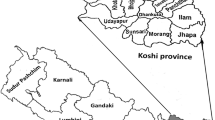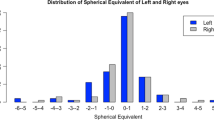Abstract
A cross-sectional study was undertaken in Nakuru, Kenya to assess the prevalence of refractive error and the spectacle coverage in a population aged ≥50 years. Of the 5,010 subjects who were eligible, 4,414 underwent examination (response rate 88.1 %). LogMAR visual acuity was assessed in all participants and refractive error was measured in both eyes using a Topcon auto refractor RM8800. Detailed interviews were undertaken and ownership of spectacles was assessed. Refractive error was responsible for 51.7 % of overall visual impairment (VI), 85.3 % (n = 191) of subjects with mild VI, 42.7 % (n = 152) of subjects with moderate VI, 16.7 % (n = 3) of subjects with severe VI and no cases of blindness. Myopia was more common than hyperopia affecting 59.5 % of those with refractive error compared to 27.4 % for hyperopia. High myopia (<−5.0 DS) was also more common than extreme hyperopia (>+5.0 DS). Of those who needed distance spectacles (spectacle coverage), 25.5 % owned spectacles. In conclusion, the oldest, most poor and least educated are most likely to have no spectacles and they should be specifically targeted when refractive services are put in place.
Similar content being viewed by others
References
Pascolini D, Mariotti SP (2011) Global estimates of visual impairment: 2010. Br J Ophthalmol. Epub 2011/12/03
Foster A, Resnikoff S (2005) The impact of Vision 2020 on global blindness. Eye 19(10):1133–1135. Epub 2005/11/24
Smith TS, Frick KD, Holden BA, Fricke TR, Naidoo KS (2009) Potential lost productivity resulting from the global burden of uncorrected refractive error. Bull World Health Organ 87(6):431–437. Epub 2009/07/01
Frick KD, Riva-Clement L, Shankar MB (2009) Screening for refractive error and fitting with spectacles in rural and urban India: cost-effectiveness. Ophthalmic Epidemiol 16(6):378–387. Epub 2009/12/10
Resnikoff S, Pascolini D, Mariotti SP, Pokharel GP (2008) Global magnitude of visual impairment caused by uncorrected refractive errors in 2004. Bull World Health Organ 86(1):63–70. Epub 2008/02/01
Sherwin JC, Lewallen S, Courtright P (2012) Blindness and visual impairment due to uncorrected refractive error in sub-Saharan Africa: review of recent population-based studies. Br J Ophthalmol 96(7):927–930. Epub 2012/02/10
Mathenge W, Kuper H, Limburg H, Polack S, Onyango O, Nyaga G et al (2007) Rapid assessment of avoidable blindness in Nakuru district, Kenya. Ophthalmology 114(3):599–605. Epub 2006/12/05
Mathenge W, Bastawrous A, Foster A, Kuper H (2012) The Nakuru posterior segment eye disease study: methods and prevalence of blindness and visual impairment in Nakuru, Kenya. Ophthalmology 119(10):2033–2039. Epub 2012/06/23
Statistics KKNBo (2010) Kenya 2009 population and housing census highlights
Bureau USC (2005) Demographic data for Kenya: international data base. IDB Summary
Turner AG, Magnani RJ, Shuaib M (1996) A not quite as quick but much cleaner alternative to the Expanded Programme on Immunization (EPI) Cluster Survey design. Int J Epidemiol 25(1):198–203
Rosser DA, Laidlaw DA, Murdoch IE (2001) The development of a ‘reduced logMAR’ visual acuity chart for use in routine clinical practice. Br J Ophthalmol 85(4):432–436
Mathenge W, Foster A, Kuper H (2010) Urbanization, ethnicity and cardiovascular risk in a population in transition in Nakuru, Kenya: a population-based survey. BMC Public Health 10:569. Epub 2010/09/24
Bourne RR, Dineen BP, Ali SM, Noorul Huq DM, Johnson GJ (2004) Prevalence of refractive error in Bangladeshi adults: results of the National Blindness and Low Vision Survey of Bangladesh. Ophthalmology 111(6):1150–1160. Epub 2004/06/05
Kuper H, Polack S, Eusebio C, Mathenge W, Wadud Z, Foster A (2008) A case-control study to assess the relationship between poverty and visual impairment from cataract in Kenya, the Philippines, and Bangladesh. PLoS Med 5(12):e244. Epub 2008/12/19
Polack S, Kuper H, Mathenge W, Fletcher A, Foster A (2007) Cataract visual impairment and quality of life in a Kenyan population. Br J Ophthalmol 91(7):927–932. Epub 2007/02/03
World Health Organisation G (2000) Obesity: preventing and managing in global epidemic. Report of a WHO Consultation on obesity. Technical Report Series, vol 894, pp i–xii, 1–253
Office DS (2001) Nakuru demographic data. Nakuru
Sawada A, Tomidokoro A, Araie M, Iwase A, Yamamoto T, Tajimi Study Group (2008) Refractive errors in an elderly Japanese population: the Tajimi study. Ophthalmology 115(2):363–70.e3
Evans JR, Fletcher AE, Wormald RPL (2004) Causes of visual impairment in people aged 75 years and older in Britain: an add-on study to the MRC Trial of Assessment and Management of Older People in the Community. Br J Ophthalmol 88 (3):365–370
Foran SRK, Wang JJ, Mitchell P (2002) Correctable visual impairment in an older population: the blue mountains eye study. Am J Ophthalmol 134(5):712–719
Limburg H, von-Bischhoffshausen FB, Gomez P, Silva JC, Foster A (2008) Review of recent surveys on blindness and visual impairment in Latin America. Br J Ophthalmol 92(3):315–319
Liang YB, Wong TY, Sun LP, Tao QS, Wang JJ, Yang XH, Xiong Y, Wang NL, Friedman DS (2009) Refractive errors in a rural Chinese adult population the Handan eye study. Ophthalmology 16(11):2119–2127
Abdull MM, Sivasubramaniam S, Murthy GVS, Gilbert C, Abubakar T, Ezelum C et al (2009) Causes of blindness and visual impairment in Nigeria: the Nigeria national blindness and visual impairment survey. Invest Ophthalmol Vis Sci 50(9):4114–4120
Budenz DL, Bandi JR, Barton K, Nolan W, Herndon L, Whiteside-de Vos J et al (2012) Blindness and visual impairment in an urban West African population: the Tema Eye Survey. Ophthalmology 119(9):1744–1753. Epub 2012/06/09
Sherwin JC, Keeffe JE, Kuper H, Islam FM, Muller A, Mathenge W (2008) Functional presbyopia in a rural Kenyan population: the unmet presbyopic need. Clin Exp Ophthalmol 36(3):245–251. Epub 2008/04/17
Laviers HR, Omar F, Jecha H, Kassim G, Gilbert C (2010) Presbyopic spectacle coverage, willingness to pay for near correction, and the impact of correcting uncorrected presbyopia in adults in Zanzibar, East Africa. Invest Ophthalmol Vis Sci 51(2):1234–1241. Epub 2010/01/01
Laviers H (2007) The prevalence of presbyopia and the feasibility of community distribution of near spectacles in adults in Zanzibar, East Africa. Community Eye Health 20(64):73. Epub 2008/03/12
Habiyakare C, Lewallen S, Courtright P (2010) Presbyopic spectacles in elderly Tanzanians. Invest Ophthalmol Vis Sci 51(12):6897–6898. Epub 2010/12/03
Bastawrous A, Aldawoud M (2011) More than meets the eye in correcting refractive error in low income countries. Br Med J 343:d5789. Epub 2011/09/23
Acknowledgments
Supported by grants from the British Council for the Prevention of Blindness (BCPB) and the Fred Hollows Foundation [Wanjiku Mathenge]. Andrew Bastawrous is funded by a Medical Research Council and Fight for Sight Fellowship and is in receipt of an International Glaucoma Association Award and a BCPB pump-priming grant.
Conflict of interest
The authors have no proprietary or commercial interest in any of the materials discussed in this article.
Author information
Authors and Affiliations
Corresponding author
Additional information
Andrew Bastawrous, Wanjiku Mathenge, Hannah Kuper Joint First Authors.
Electronic supplementary material
Below is the link to the electronic supplementary material.
Rights and permissions
About this article
Cite this article
Bastawrous, A., Mathenge, W., Foster, A. et al. Prevalence and predictors of refractive error and spectacle coverage in Nakuru, Kenya: a cross-sectional, population-based study. Int Ophthalmol 33, 541–548 (2013). https://doi.org/10.1007/s10792-013-9742-6
Received:
Accepted:
Published:
Issue Date:
DOI: https://doi.org/10.1007/s10792-013-9742-6




